Method of Tillage with the Factor Determining the Quality of Organic Matter
Abstract
1. Introduction
2. Materials and Methods
2.1. Materials
2.2. Methods
2.3. Statistical Analyses
3. Results and Discussion
3.1. Content of Total Organic Carbon and Total Nitrogen
3.2. Content of Dissolved Organic Matter (DOM)
3.3. Fraction Composition
4. Conclusions
Author Contributions
Funding
Conflicts of Interest
References
- Blair, N.; Faulkner, R.D.; Till, A.R.; Poulton, P.R. Long-term management impacts on soil C, N and physical fertility. Part 1. Broadbalk experiment. Soil Tillage Res. 2006, 91, 30–38. [Google Scholar] [CrossRef]
- Lal, R. Sequestering carbon in soils of agro-ecosystems. Food Policy 2011, 36, 533–539. [Google Scholar] [CrossRef]
- Smith, P.; Falloon, P. Carbon sequestration in European croplands. SEB Exp. Biol. Ser. 2005, 47–55. [Google Scholar] [CrossRef]
- Blanco-Canqui, M.; Ruis, S.J. No-tillage and soil physical environment. Geoderma 2018, 326, 164–200. [Google Scholar] [CrossRef]
- Wiesmeier, M.; Urbanski, L.; Hobley, E.; Lang, B.; von Lutzow, B.; Marin-Spiotta, E.; van Wesemael, B.; Rabot, E.; Ließ, M.; Garcia-Franco, N.; et al. Soil organic carbon storage as a key function of soils—A review of drivers and indicators at various scales. Geoderma 2019, 333, 149–162. [Google Scholar] [CrossRef]
- COM (2006) 231 Final, Brussels, 22.9.2006. Communication from the Commission to the Council, the European Parliament, the European Economic and Social Committee and the Committee of the Regions Thematic Strategy for Soil Protection. Commission of the European Communities. 2006. Available online: http://eur-lex.europa.eu/legal-content/EN/TXT/PDF/?uri=CELEX:52006DC0231&from=EN (accessed on 25 August 2020).
- Kalbitz, K.; Solinger, S.; Park, J.H.; Michalzik, B.; Matzner, E. Controls on the dynamics of organic matter in soils: A review. Soil Sci. 2000, 165, 277–304. [Google Scholar] [CrossRef]
- Chantigny, M.H. Dissolved and water-extractable organic matter in soils: A review on the influence of land use and management practice. Geoderma 2003, 113, 357–380. [Google Scholar] [CrossRef]
- Rosa, E.; Debska, B. Seasonal changes in the content of dissolved organic matter in arable soils. J. Soils Sediments 2018, 18, 2703–2714. [Google Scholar] [CrossRef]
- Friedrich, T.; Derpsch, R.; Kassam, A.H. Global overview of the spread of conservation agriculture. J. Agric. Sci. Technol. 2012, 6, 1–7. [Google Scholar]
- Lozano-Garcia, B.; Parras-Alcantara, L. Land use and management effects on carbon and nitrogen in Mediterranean Cambisols. Agric. Ecosyst. Environ. 2013, 179, 208–214. [Google Scholar] [CrossRef]
- Busari, A.M.; Kukal, S.S.; Kaur, A.; Bhatt, R.; Dulazi, A.A. Conservation tillage impacts on soil, crop and the environment. Int. Soil Water Conserv. Res. 2015, 3, 119–129. [Google Scholar] [CrossRef]
- Pittelkow, C.M.; Linquist, B.A.; Lundy, M.E.; Liang, X.; van Groenigen, K.J.; Lee, J.; van Gestel, N.; Six, J.; Venterea, R.T.; van Kessel, C. When does no-till yield more? A global meta-analysis. Field Crop. Res. 2014, 183, 156–168. [Google Scholar] [CrossRef]
- Wezel, A.; Casagrande, M.; Celette, F.; Vian, J.F.; Ferrer, A.; Peigne, J. Agroecological practices for sustainable agriculture. A review. Agron. Sustain. Dev. 2014, 34, 1–20. [Google Scholar] [CrossRef]
- Williams, A.; Davis, A.S.; Ewing, P.M.; Grandy, A.S.; Kane, D.A.; Koide, R.T.; Mortensen, D.A.; Smith, R.G.; Snapp, S.S.; Spokas, K.A.; et al. A comparison of soil hydrothermal properties in zonal and uniform tillage systems across the US Corn Belt. Geoderma 2016, 273, 12–19. [Google Scholar] [CrossRef]
- Reicosky, D.C. Conservation tillage is not conservation agriculture. J. Soil Water Conserv. 2015, 70, 103A–108A. [Google Scholar] [CrossRef]
- Jaskulska, I.; Jaskulski, D. Strip-till one-pass technology in Central and Eastern Europe: A MZURI Pro-Til Hybrid Machine Case Study. Agronomy 2020, 10, 925. [Google Scholar] [CrossRef]
- Celik, A.; Altikat, S.; Way, T.R. Strip tillage width effects on sunflower seed emergence and yield. Soil Tillage Res. 2013, 131, 20–27. [Google Scholar] [CrossRef]
- Leskovar, D.; Othman, Y.; Dong, X. Strip tillage improves soil biological activity, fruit yield and sugar content of triploid watermelon. Soil Tillage Res. 2016, 163, 266–273. [Google Scholar] [CrossRef]
- Jaskulska, I.; Galezewski, L.; Piekarczyk, M.; Jaskulski, D. Strip-till technology—A method for uniformity in the emergence and plant growth of winter rapeseed (Brassica napus L.) in different environmental conditions of Northern Poland. Ital. J. Agron. 2018, 13, 194–199. [Google Scholar] [CrossRef]
- Jaskulska, I.; Galazka, A.; Jaskulski, D. Strip-till as a means of decreasing spatial variability of winter barley within a field scale. Acta Agric. Scand. Sect. B Plant Soil Sci. 2019, 69, 516–527. [Google Scholar] [CrossRef]
- Idowu, O.J.; Sultana, S.; Darapuneni, M.; Beck, L.; Steiner, R. Short-term conservation tillage effects on corn silage yield and soil quality in an irrigated, arid agroecosystem. Agronomy 2019, 9, 455. [Google Scholar] [CrossRef]
- Jaskulska, I.; Jaskulski, D.; Rozniak, M.; Radziemska, M.; Galezewski, L. Zonal tillage as innovative element of the technology of growing winter wheat: A field experiment under low rainfall conditions. Agriculture 2020, 10, 105. [Google Scholar] [CrossRef]
- Laufer, D.; Loibl, B.; Marlander, B.; Koch, H.J. Soil erosion and surface run-off under strip tillage for sugar beet (Beta vulgaris L.) in Central Europe. Soil Tillage Res. 2016, 162, 1–7. [Google Scholar] [CrossRef]
- Islam, A.K.M.S.; Saleque, M.A.; Hossain, M.M.; Islam, A.K.M.A. Effect of conservation tillage on soil chemical properties in rice-maize cropping system. Agriculturists 2015, 13, 62–73. [Google Scholar] [CrossRef]
- Fernandez, F.G.; Sorensen, B.A.; Villamil, M.B. A comparison of soil properties after five years of no-till and strip-till. Agron. J. 2015, 107, 1339–1346. [Google Scholar] [CrossRef]
- Powlson, D.S.; Bhogal, A.; Chambers, B.J.; Coleman, K.; Macdonald, A.J.; Goulding, K.W.T.; Whitmore, A.P. The potential to increase soil carbon stocks through reduced tillage or organic material additions in England and Wales: A case study. Agric. Ecosyst. Environ. 2012, 146, 23–33. [Google Scholar] [CrossRef]
- Al-Kaisi, M.; Yin, X. Tillage and crop residue effects on soil carbon and carbon dioxide emission in corn–soybean rotations. J. Environ. Qual. 2005, 34, 437–445. [Google Scholar] [CrossRef]
- Strickland, T.C.; Scully, B.T.; Hubbard, R.K.; Sullivan, D.G.; Abdo, Z.; Savabi, M.R.; Lee, R.D.; Olson, D.M.; Hawkins, G.L. Effect of conservation practices on soil carbon and nitrogen accretion and crop yield in a corn production system in the southeastern coastal plain, United States. J. Soil Water Conserv. 2015, 70, 170–181. [Google Scholar] [CrossRef]
- Si, P.; Liu, E.; He, W.; Sun, Z.; Dong, W.; Yan, C.; Zhang, Y. Effect of no-tillage with straw mulch and conventional tillage on soil organic carbon pools in Northern China. Arch. Agron. Soil Sci. 2017, 64, 398–408. [Google Scholar] [CrossRef]
- Bolan, N.S.; Adriano, D.C.; Kunhikrishnan, A.; James, T.; McDowell, R.; Senesi, N. Dissolved organic matter: Biogeochemistry, dynamics, and environmental significance in soils. Adv. Agron. 2011, 110, 1–75. [Google Scholar] [CrossRef]
- Gonet, S.S.; Debska, B. Dissolved organic carbon and dissolved nitrogen in soil under different fertilization treatments. Plant Soil Environ. 2006, 52, 55–63. [Google Scholar] [CrossRef]
- Orlov, D.S. Humus Acids of Soils; AA Balkema: Rotterdam, The Netherlands, 1986. [Google Scholar]
- Yang, Z.H.; Singh, B.R.; Sitaula, B.K. Soil organic carbon fractions under different land uses in Mardi Watershed of Nepal. Commun. Soil Sci. Plant Anal. 2004, 35, 615–629. [Google Scholar] [CrossRef]
- Ventorino, V.; De Marco, A.; Pepe, O.; De Santo, A.V.; Moschetti, G. Impact of innovative agricultural practices of carbon sequestration on soil microbial community. In Carbon Sequestration in Agricultural Soils; Piccolo, A., Ed.; Springer: Berlin/Heidelberg, Germany, 2011; pp. 145–179. [Google Scholar] [CrossRef]
- Debska, B.; Drag, M.; Tobiasova, E. Effecf of post-harvest residue of maize, rapeseed, and sunflower on humic acids properties in various soils. Pol. J. Environ. Stud. 2012, 21, 603–613. [Google Scholar]
- Debska, B.; Dlugosz, J.; Piotrowska-Dlugosz, A.; Banach-Szott, M. The impact of a bio- fertilizer on the soil organic matter status and carbon sequestration—Results from a field-scale study. J. Soils Sediments 2016, 16, 2335–2343. [Google Scholar] [CrossRef]
- Gomez, K.A.; Gomez, A.A. Statistical Procedures for Agricultural Research; John Wiley and Sons: New York, NY, USA, 1983. [Google Scholar]
- Andruschkiewitsch, R.; Geisseler, D.; Koch, H.J.; Ludwig, B. Effects of tillage on contents of organic carbon, nitrogen, water-stable aggregates and light fraction four different long-term trials. Geoderma 2013, 192, 368–377. [Google Scholar] [CrossRef]
- Wright, A.; Dou, F.; Hons, M.F. Soil organic C and N distribution for wheat cropping systems after 20 years of conservation tillage in central Texas. Agric. Ecosyst. Environ. 2007, 121, 376–382. [Google Scholar] [CrossRef]
- Liu, E.; Teclemariam, S.G.; Yan, C.; Yu, J.; Gu, R.; Liu, S.; He, W.; Liu, Q. Long-term effects no-tillage management practice on soil organic carbon and its fractions in the northern China. Geodema 2014, 213, 379–384. [Google Scholar] [CrossRef]
- Leinweber, P.; Schulten, H.R.; Kalbitz, K.; Meissner, R.; Jancke, H. Fulvic acid composition in degraded fenlands. J. Plant Nutr. Soil Sci. 2001, 164, 371–379. [Google Scholar] [CrossRef]
- Guimaraes, D.V.; Gonzaga, M.I.S.; da Silva, T.O.; da Silva, T.L.; da Silva Dias, N.; Matias, M.I.S. Soil organic matter pools and carbon fractions in soil under different land uses. Soil Tillage Res. 2013, 126, 177–183. [Google Scholar] [CrossRef]
- Zibilske, L.M.; Bradford, J.M. Soil aggregation, aggregate carbon and nitrogen, and moisture retention induced by conservation tillage. Soil Sci. Soc. Am. J. 2007, 71, 793–802. [Google Scholar] [CrossRef]
- Zhu, L.; Hu, N.; Yang, M.; Zhan, X.; Zhang, Z. Effects of different tillage. and straw return on soil organic carbon in a rice-wheat rotation system. PLoS ONE 2014, 9, e88900. [Google Scholar] [CrossRef] [PubMed]
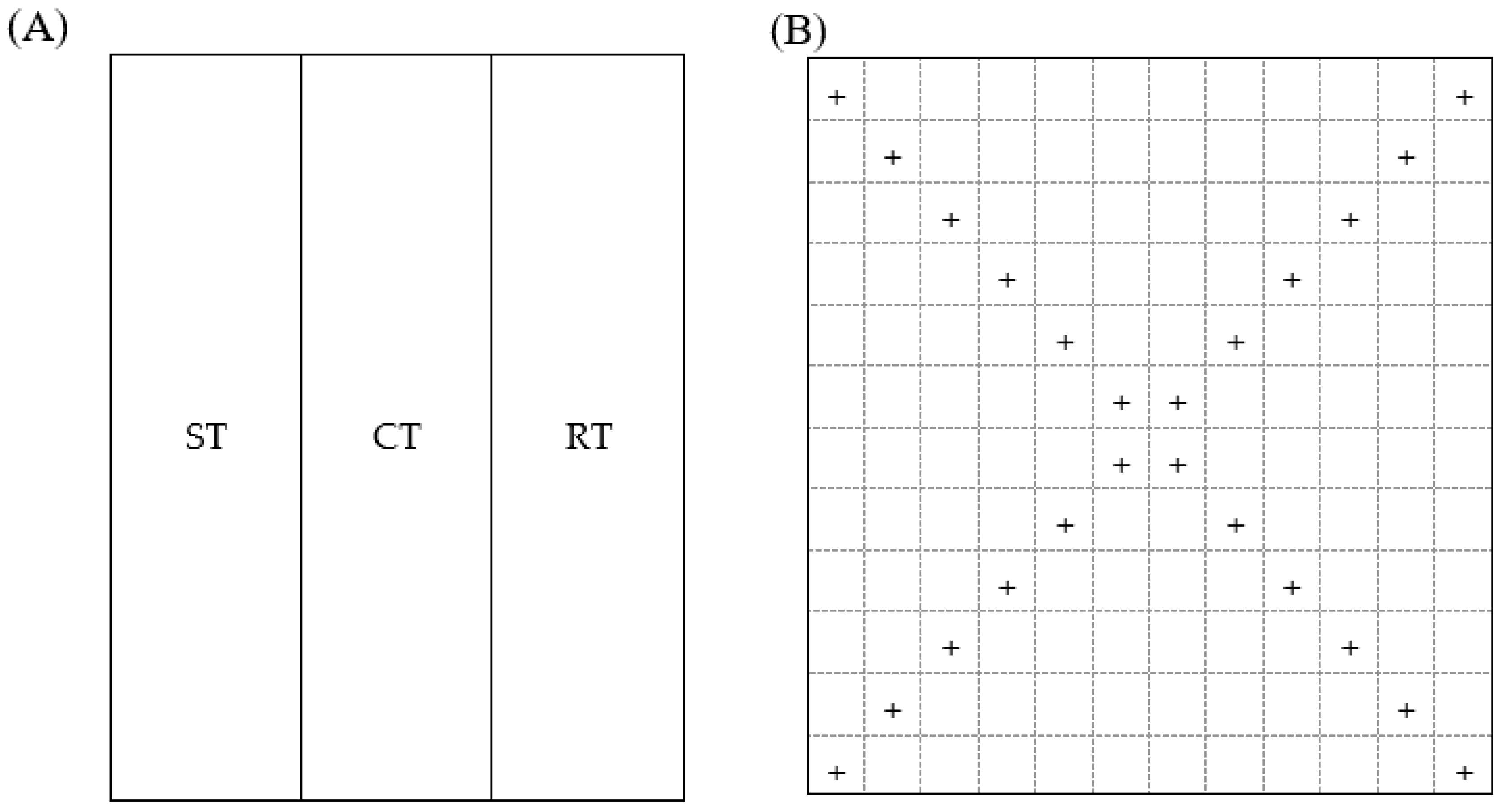
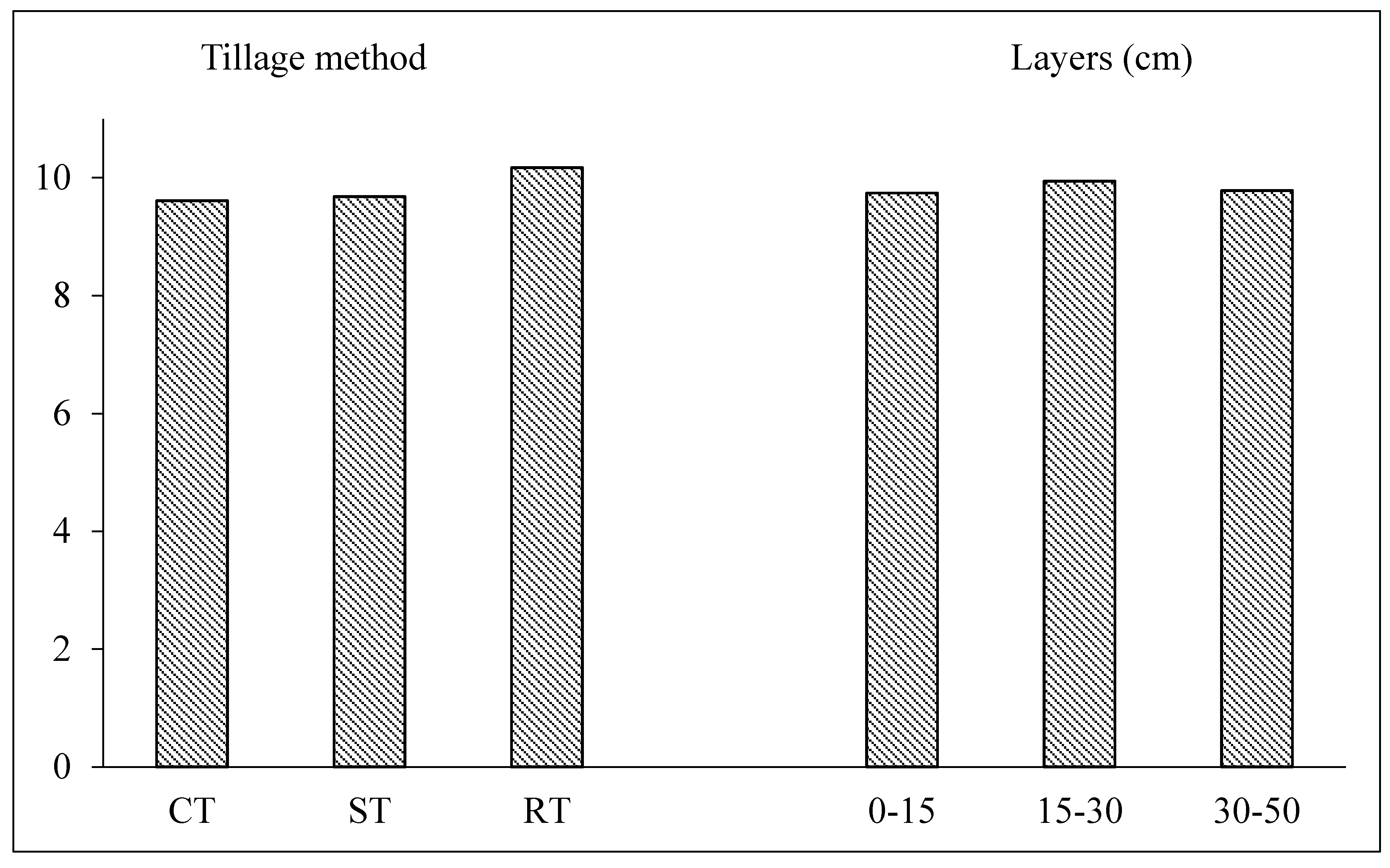
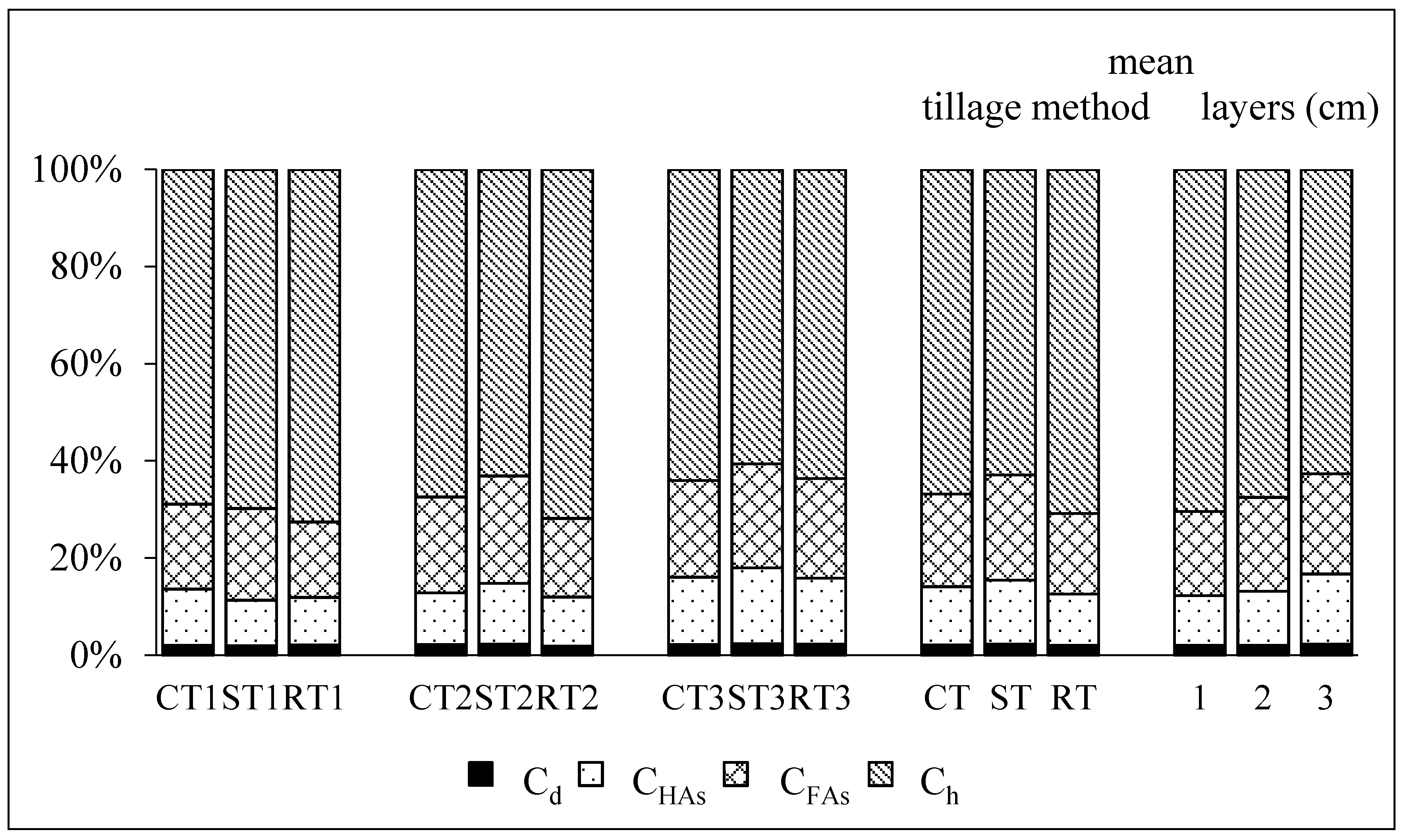
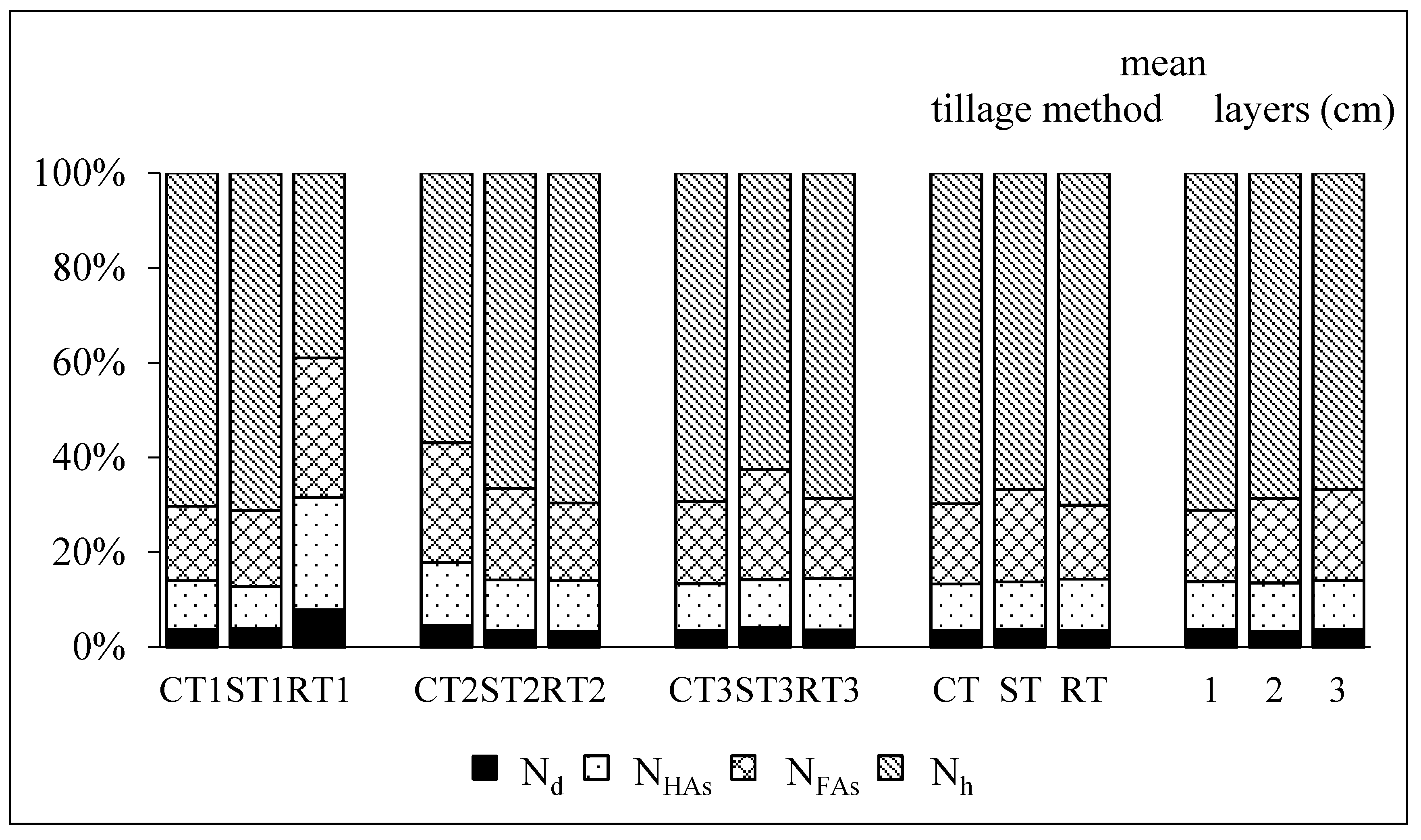
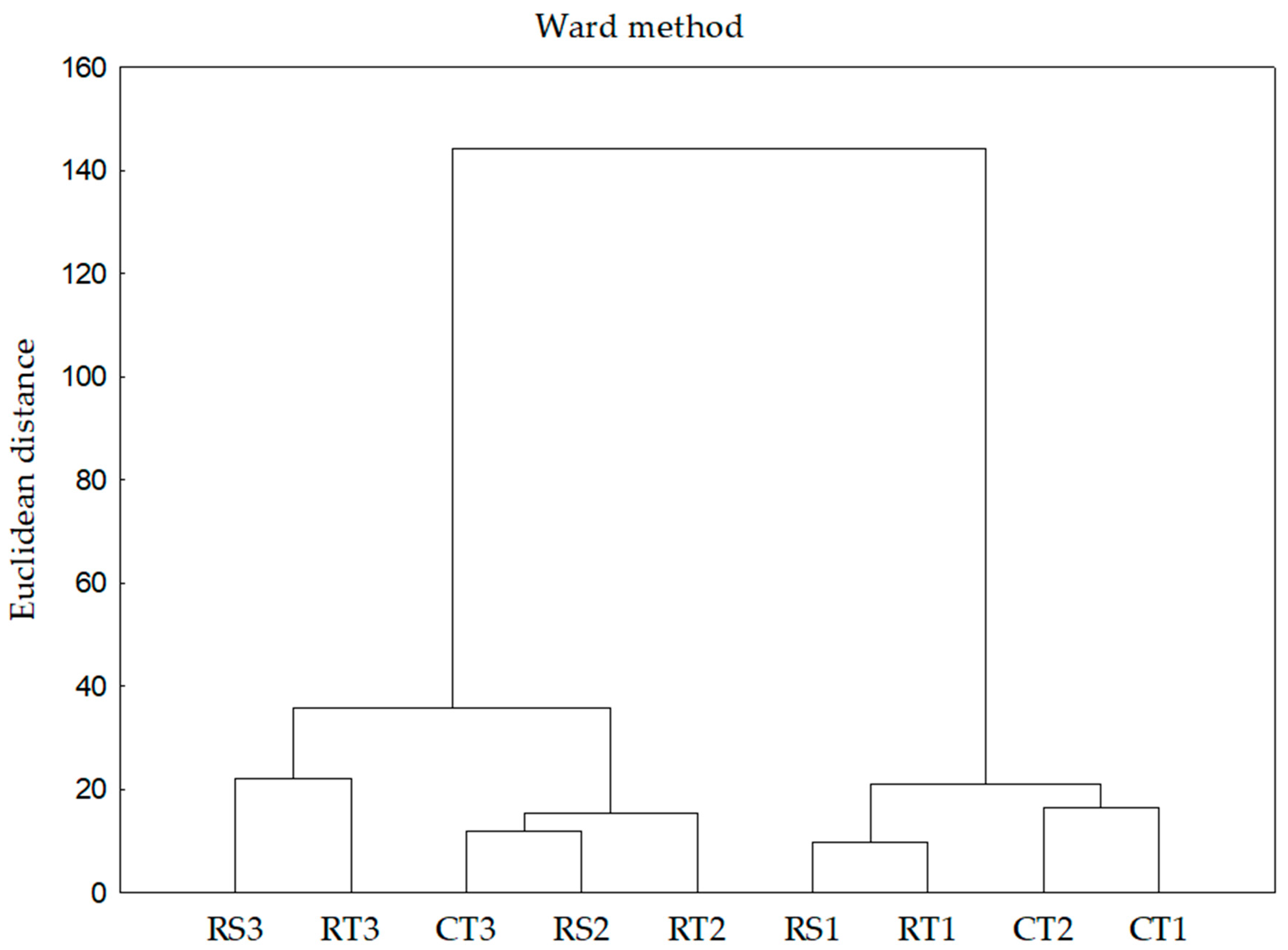
| Tillage Method | Layers (cm) | TOC (g kg−1) | Nt (g kg−1) | DOC (mg kg−1) | DOC (%) | DNt (mg kg−1) | DNt (%) |
|---|---|---|---|---|---|---|---|
| CT | 0–15 | 11.98 | 1.22 | 209.9 | 1.76 | 38.4 | 3.16 |
| 15–30 | 11.43 | 1.20 | 224.9 | 1.96 | 32.7 | 2.75 | |
| 30–50 | 9.00 | 0.92 | 178.7 | 1.99 | 29.1 | 3.06 | |
| ST | 0–15 | 12.81 | 1.33 | 230.5 | 1.80 | 46.2 | 3.52 |
| 15–30 | 9.64 | 1.09 | 189.4 | 1.97 | 31.3 | 3.16 | |
| 30–50 | 7.15 | 0.88 | 173.0 | 2.42 | 24.8 | 3.44 | |
| RT | 0–15 | 13.88 | 1.32 | 222.5 | 1.60 | 45.2 | 3.15 |
| 15–30 | 11.22 | 1.03 | 192.1 | 1.71 | 30.1 | 2.94 | |
| 30–50 | 9.42 | 0.72 | 159.6 | 1.69 | 26.9 | 2.83 | |
| Results of the analysis of variance | |||||||
| Factor I | CT | 10.80 | 1.13 | 204.5 | 1.90 | 33.4 | 2.99 |
| Tillage | ST | 9.87 | 1.02 | 197.6 | 1.67 | 34.1 | 3.37 |
| method | RT | 11.50 | 1.15 | 191.4 | 2.06 | 34.1 | 2.97 |
| LSD | 0.733 | 0.084 | 3.88 | 0.040 | n.s.* | 0.294 | |
| Factor II | 0–15 | 12.89 | 1.33 | 221.0 | 1.72 | 43.3 | 3.28 |
| Layers | 15–30 | 10.76 | 1.09 | 202.1 | 1.88 | 31.4 | 2.95 |
| (cm) | 30–50 | 8.52 | 0.88 | 170.4 | 2.03 | 26.9 | 3.11 |
| LSD | 0.609 | 0.112 | 6.37 | 0.080 | 2.33 | 0.262 | |
| Interactions | |||||||
| I/II | 1.13 | 0.178 | 9.79 | 0.120 | 3.54 | n.s. | |
| II/I | 1.054 | 0.193 | 11.04 | 0.139 | 4.04 | n.s. | |
| Tillage Method | Layers (cm) | Cd | CHAs | CFAs | CHAs/ CFAs | Nd | NHAs | NFAs | NHAs/ NFAs |
|---|---|---|---|---|---|---|---|---|---|
| CT | 0–15 | 240.9 | 1382 | 2093 | 0.66 | 44.9 | 124.1 | 190.4 | 0.66 |
| 15–30 | 230.5 | 1220 | 2257 | 0.54 | 36.3 | 106.9 | 201.6 | 0.53 | |
| 30–50 | 198.0 | 1245 | 1782 | 0.70 | 32.9 | 94.2 | 165.2 | 0.57 | |
| ST | 0–15 | 255.5 | 1199 | 2413 | 0.50 | 50.7 | 117.9 | 211.1 | 0.56 |
| 15–30 | 217.4 | 1219 | 2128 | 0.57 | 35.4 | 111.0 | 199.5 | 0.55 | |
| 30–50 | 192.4 | 1256 | 1710 | 0.74 | 29.4 | 72.5 | 166.0 | 0.44 | |
| RT | 0–15 | 290.0 | 1360 | 2152 | 0.63 | 52.0 | 157.9 | 195.6 | 0.81 |
| 15–30 | 211.0 | 1132 | 1807 | 0.63 | 34.8 | 109.1 | 168.9 | 0.64 | |
| 30–50 | 189.6 | 1112 | 1690 | 0.66 | 34.3 | 99.8 | 159.2 | 0.63 | |
| Results of the analysis of variance | |||||||||
| Factor I | CT | 223.1 | 1282 | 2044 | 0.63 | 38.0 | 108.4 | 185.7 | 0.59 |
| Tillage | ST | 221.8 | 1225 | 2084 | 0.60 | 38.5 | 100.5 | 192.2 | 0.52 |
| method | RT | 230.2 | 1201 | 1883 | 0.64 | 40.4 | 122.3 | 174.6 | 0.69 |
| LSD | 8.68 | 27.3 | 110.9 | – | 2.15 | 5.14 | 15.31 | – | |
| Factor II | 0–15 | 262.1 | 1314 | 2220 | 0.60 | 49.2 | 133.3 | 199.0 | 0.68 |
| Layers | 15–30 | 219.6 | 1190 | 2064 | 0.58 | 35.5 | 109.0 | 190.0 | 0.57 |
| (cm) | 30–50 | 193.3 | 1204 | 1727 | 0.70 | 32.2 | 88.8 | 163.5 | 0.55 |
| LSD | 13.17 | 72.7 | 103.9 | – | 1.92 | 8.44 | 7.29 | – | |
| Interactions | |||||||||
| I/II | 20.51 | 106.3 | 183.5 | – | 3.45 | 12.97 | 18.38 | – | |
| II/I | 22.81 | 126.0 | 180.0 | – | 3.32 | 14.61 | 12.62 | – | |
© 2020 by the authors. Licensee MDPI, Basel, Switzerland. This article is an open access article distributed under the terms and conditions of the Creative Commons Attribution (CC BY) license (http://creativecommons.org/licenses/by/4.0/).
Share and Cite
Debska, B.; Jaskulska, I.; Jaskulski, D. Method of Tillage with the Factor Determining the Quality of Organic Matter. Agronomy 2020, 10, 1250. https://doi.org/10.3390/agronomy10091250
Debska B, Jaskulska I, Jaskulski D. Method of Tillage with the Factor Determining the Quality of Organic Matter. Agronomy. 2020; 10(9):1250. https://doi.org/10.3390/agronomy10091250
Chicago/Turabian StyleDebska, Bozena, Iwona Jaskulska, and Dariusz Jaskulski. 2020. "Method of Tillage with the Factor Determining the Quality of Organic Matter" Agronomy 10, no. 9: 1250. https://doi.org/10.3390/agronomy10091250
APA StyleDebska, B., Jaskulska, I., & Jaskulski, D. (2020). Method of Tillage with the Factor Determining the Quality of Organic Matter. Agronomy, 10(9), 1250. https://doi.org/10.3390/agronomy10091250





